
View Latest Data |

|
Log-in Register |
||||||||||
| Title: | So you thought all Ford Transits were the same | |||||||||||||||
| Summary: | If you can't tell your LWB Mid-Height Mk3s from your SWB Low-Roof Mk7s then this illustrated overview should help. | |||||||||||||||
| Category: | Vehicles | |||||||||||||||
| Author: | Thomas Young | |||||||||||||||
| Posted: | 26/01/2010 | |||||||||||||||
| Last updated: | 24/03/2022 | |||||||||||||||
| Download: | article003.pdf | |||||||||||||||
| Content: |
Ford Transits
Introduction The Ford Transit was first introduced in 1965 and, over the following years, became the backbone of many British road fleets, not least London Transport's. Through several facelifts and redesigns, it has continued to be the principal type for general freight duties as well as some more specialised roles. This article will look at the evolution of the model, with illustrations of the major variants. Click on any labelled thumbnail to see a full-size image. London Transport bought its first Ford Transits in April 1966 and numbered them 1410F-1415F. Although these all later passed to London Country Bus Services (LCBS), many more similar vehicles followed, including 2019F (shown left) in 1977. This represents the standard 12 or 14 cwt van, which could have either sliding or hinged cab doors. The type was also available as a minibus and this similarly became a regular feature in the service vehicle fleet. 1600F shown on the right was a 12-seat model new in 1970. Variations of the Mk1 Transit included long-wheelbase versions with a higher roofline (such as 1541F on the left), Parcels Van types with a taller, upright windscreen and flat bodysides (1631F right) and the rather odd-looking 'laundry' vans (1542F, below left). Detail differences resulted from the type of engine fitted. Diesel versions had a squarish grille that protruded into the bonnet line, while petrol ones carried a shallower but wider grille. Both types carried the same raised headlamps. Research has suggested that the only petrol-engined Transits operated by LT were four minibuses bought in 1974, one of which was 1878F shown on the right. The Mk2 Transit first appeared in about 1980 and was a fairly basic restyling of the Mk1. Most of the changes were confined to the front and included a smoothing out of the panels and the fitting of a shallow, matt black radiator grille incorporating square or circular headlamps. More subtle changes were the fitting of black bumpers and windscreen surrounds. 2299F on the left was new in October 1980 and shows the short wheelbase model. On the right is 3000F, in the numbering series introduced for leased vehicles in 1982. This is of the longer-wheelbase model, which also featured a higher roof-line and flared rear wheelarches. Note that this example was fitted with sliding cab doors. The design was slightly modified in about 1983 when a more pronounced radiator grille started to be used. This featured more deeply recessed slats and headlamps, and the black mouldings were now carried around the side indicators. A594ENJ on the left was a short-wheelbase version that had been new to LCBS as 65F in June 1984. Long-wheelbase 3199F on the right shows the changes more clearly against the standard grey livery. At about the same time, the first non-van Transits appeared in the service vehicle fleets. 3355F on the left was the first Transit dropside operated by London Transport and was leased in July 1986. A966KEH on the right shows the crewcab variant of this, although the smaller door and lack of windows must have made the back seats seem claustrophobic. Both these vehicles are to the revised Mk2 design. A more radical restyling of the Transit took place in 1986. The grille and bonnet were reprofiled to flow into the windscreen, giving a much more streamlined appearance. At the same time the side panels were changed such that the position of side windows was indicated by pressings even when they were not fitted. 3383F on the left was new in January 1987 and illustrates the 'standard' short-wheelbase version. 3952F on the right is a similar vehicle but with the rarer sliding cab door option. As with the Mk2 Transit, the long wheelbase Mk3 had a higher roofline, although this now became known as mid-height due to the introduction of taller variants. They also featured corrugated roof panels as seen on 3527F on the left. The wheelbase was only slightly longer than the short version, with the rear overhang being considerably longer. The mid-height option was also available on short-wheelbase vans but this combination was rarely featured on service vehicles. One example was blue 3540F (right). A popular option on the Transit was the addition of side windows, usually to vans fitted with a second row of seats (referred to here as crew vans). 3663F on the left had windows on both sides, while others had them on just one. As mentioned above, a taller height option was introduced for the long-wheelbase Mk3 Transit van. This differed from the mid-height roof in not being corrugated, although it did feature a horizontal seam on the sides and two grooves along the top for strength. 3930F on the left was one of five such vehicles taken into the leased fleet in 1990. The Mk3 minibus was nearly always specified with a mid-height roof, even when on a short-wheelbase. The two side windows on SWB minibus 3851F (left) equate to the two side panels on 3383F above. The LWB minibuses featured three side windows as seen on 3705F on the right. Some Transits were specified as 'Combi' models, which could be converted from minibus to goods use fairly easily. 3657F on the left is similar to 3851F above but curiously lacks the sliding side access door. 3453F on the right also lacks a side door and was a rare example of a low-roof Transit with windows. The mesh behind the front seats was common on combi vans. The Mk3 Transit was also available in other formats, including tippers, dropsides and Luton vans. 3860F on the left was a basic dropside truck with bolster, while 3695F on the right shows the crew-cab version. Note that no doors were provided for the rear seats.  Mk3 The Mk4 Transit was introduced towards the end of 1991 and featured the same bodyshell design with a few mechanical and cosmetic changes. The key recognition factor was the shape of the headlamps, these changing from being fairly square (Mk3 headlamp on the left) to having a rounded inner top corner (Mk4 headlamp on the right). The shape of the bonnet was changed slightly to suit. 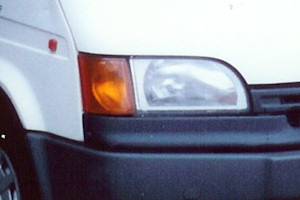 Mk4 The only other apparent change was that the wheelbase on LWB examples was extended while keeping the body length the same (resulting in a shorter rear overhang). Compare mid-height Mk4 4219F (left) with Mk3 3527F above, and also high-roof Mk4 2520F (right) with 3930F above. The range of body styles and sizes was otherwise unchanged. The Mk5 Transit first appeared in autumn 1994 and was again a fairly minor facelift. The headlamps and bonnet from the Mk4 were retained but the panel underneath was changed from a black plastic moulding to a body-coloured one featuring a rounded grille opening (leading to the 'smiley' nickname for this variant). The Ford badge was moved down from the bonnet to the center of this grille. Short wheelbase 5066F is on the left, with long-wheelbase mid-height 4989F on the right. Another small change on the Mk5 was the addition of a black plastic grille on the rear corners, seen left on 4718F. This van is rather unusual for having a one-piece rear door, hinged at the top. Most Transits had two part doors, hinged at the sides. Another unusual vehicle was Mobile Control Center 4687F, shown on the right. Based on a high-roof long-wheelbase van, this had full windows on the nearside but just the drivers window on the offside. Two new variants were introduced with the Mk5. Firstly, the high-roof option was made available on the short wheelbase van. This is seen to advantage on former London General T645NGW on the left. The other variant was a 'jumbo' van, combining the wheelbase of the Mk4 with the rear overhang of the Mk3. The extra length in the bodywork was accommodated by inserting a short central panel, resulting in an appearance reminiscent of the RML bus, as seen on 4852F on the right. The extended length bodywork was also available as a mid-height minibus but none have been used as service vehicles. A visual summary of all Mk3/4/5 van variants is shown below.  The Mk6 Transit was introduced in 2000 and retained the basic streamlined profile of the Mk3/4/5 but with a more angular styling and greater use of black relief around the windscreen and side windows. The three height options were carried over and shown here are low-roof 5871F (short-wheelbase, left) and mid-height 5941F (long-wheelbase, right). A fourth length option was added in the form of the medium wheelbase. Available in mid-height and high-roof formats, the former was used only occasionally as a service vehicle (as seen with TfL 5684F on the left), while the latter was used extensively by London Buses (5578F on the right). 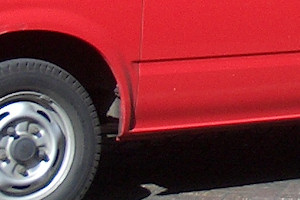 SWB Recognition of the different lengths is fairly straightforward, apart from the short and medium wheelbase variants. Most of the difference between these is taken up by using different length side doors. However, the short-wheelbase van has the rear wheelarch right behind the side door (or panel line if no door is fitted), while the medium-wheelbase van has a slight gap here. The two detail pictures shown hopefully highlight this difference. 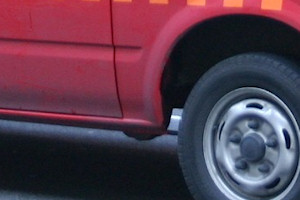 MWB 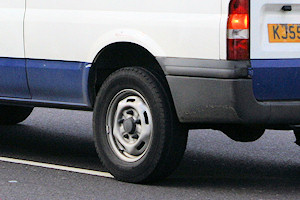 LWB The long-wheelbase van has a long section between the back of the side door (or panel line) and the rear wheel, and a black bumper moulding starts right behind the rear wheel. The extended length variant has a length of body panelling between the rear wheel and the start of the bumper moulding. In addition, the EL variants are always fitted with extra sidelights and often have flared rear wheelarches. The diagram below shows the main Mk6 Transit van variants. 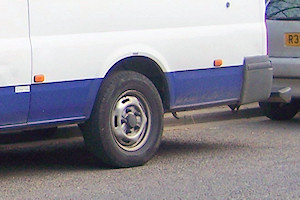 LWB EL 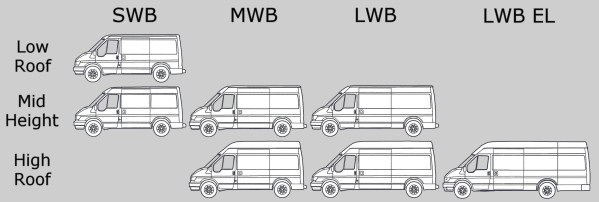 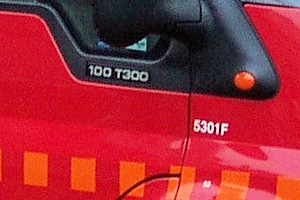 100 T300 A useful feature of the Mk6 Transit is that many carried a badge showing the model number underneath the cabside windows. On these, the lower figure (e.g. 90) is the engine power (in PS, or Indicated Horsepower), while the higher figure (e.g. 350) relates to the vehicle weight, being roundly one tenth of the Gross Vehicle Mass in KG. 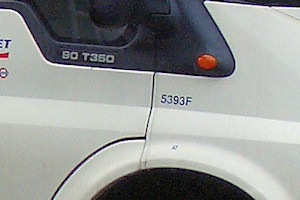 90 T350 Crew vans based on the Mk6 Transit were very popular in the central fleet, and covered most variants from the SWB Low-Roof (such as 5967F on the left), to LWB EL high-roof 'Jumbos' such as 5862F (right). It is notable that quite a few vans were delivered with plain side panels and/or doors and were later refitted with glazed units. Mk6 Transit minibuses were all mid-height, a lower height variant having been rebranded as the Tourneo (qv). Most were long wheelbase, like 5715F (left), while there were also a couple of LWB EL models like 5724F (right). This photo highlights some of the recognition features of the LWB EL vehicles, and also provides a contrast with the SWB low-roof Transit alongside. A MWB minibus was available but only one was used as a central fleet SV (5664F) (This size later become popular due to a change in driver licensing regulations; see Mark 7 Transit). A couple of non-standard Mk6 Transits are illustrated here. 5040F (left) replaced 4687F (see Mk5 above) as the London Buses Mobile Control Center, and featured a similarly unique arrangement of windows in the nearside but not on the offside. It is worth noting that it was also fitted with a nearside awning, and that the side windows were smaller than standard. 5727F (right) served a similar function with Tube Lines. The Mk6 chassis cab was available with three different wheelbase lengths, while the long-wheelbase variant was also available with an extended chassis frame (ECF). Both LWB variants could have single or double cabs, shorter versions being limited to single cabs. (The range is shown below in the section on Mk7s). In all cases, the wheelbase was about 200mm longer than that on the equivalent van. A large number of dropside trucks were taken into the leased fleet, many being fitted with tail-lifts. 5762F on the left is a MWB dropside with a single cab, while 5857F at the same location (on the right) is a LWB ECF version with crew-cab and a tail-lift. The Mk6 chassis cab was also used as the basis for tippers and box trucks, although both were very rare in the central fleet. The tippers were virtually indistinguishable from dropside trucks, one give-away being the squared-off rear wheelarches, as seen on 5722F on the left. This vehicle also features a bulk load cage as found on several dropside trucks. The only standard box truck Mk6 Transit in the central fleet was 5519F, shown on the right. Finally, three Mk6 chassis cabs were used as mobile exhibition units. On the left is 5494F operated by the LT Museum, while 5909F on the right is one of a pair of shorter Transits from the London Safety Camera Partnership. 5494F has a 'Luton' style over-cab extension, while 5909F has an aerodynamic fairing instead. The Mk7 Transit was introduced in 2006 and featured cosmetic and mechanical changes to the previous variant. Most notably, the relatively small front grille of the Mk6 was replaced with a larger grille surround moulded in black plastic (resulting in the nickname of 'Mouth-organ' Transits). The headlamps were enlarged, being swept back into the bonnet, while the shape of the moulding below the side windows was changed to eliminate the 'step'. Hired BN07ZPR on the left is a SWB low-roof van (compared to the high-roof Mk6 parked alongside) while a further comparison between mid-height 6722F and high-roof 6707F can be seen on the right. The range of van sizes for the Mk7 was initially the same as for the Mk6. However an addition during 2008 was an option of a low-roof body on a medium wheelbase chassis. Only one such van has so far been operated as an SV (6527F, left) and the lower height does make the slightly increased length more apparent. A new role for Transits in the central fleet is as staff welfare facilities, for which a number of 'Jumbo' vans have been acquired. 6727F on the right is slightly unusual in carrying an all white livery. The change to the side moulding means that the model badging is no longer carried below the windows. To the left is a comparison between Mk6 5788F and Mk7 6117F. The badging can now be found on the rear, either below the TRANSIT name (on vans like 5996F on the left in the picture on the right), or next to the registration plate on chassis cabs (like 6142F on the right). The basic Transit Mk7 has black grilles, but higher-spec variants feature body-coloured ones, changing the appearance considerably. This was seen on several demonstrators when the model was new (example on the left), but only on one 'regular' SV (6321F on the right). It also features on most Tourneo minibuses. Minibus options were as before, although the medium-wheelbase version became more popular due to changes in driver licensing regulations. 9-seat vehicles can be driven on a normal license, leading to the appearance of several like 6460F on the left. Longer vehicles were consequently less common but included Jumbo 6426F on the right. Chassis cabs continued to be popular for bodying as dropside trucks. A new option offered by Ford was for 'one-stop' bodywork, this featuring revised dropside panels and a tubular headboard and steps. The majority of central fleet dropsides were LWB ECF (extended chassis frame) models with crew-cabs, like 6735F on the left. 6571F on the right also has the new bodywork but is a rarer MWB variant with single-cab. As with the Mk6, identifying the actual length of chassis cabs is not particularly easy. The diagram below shows all the variants that were available as standard. 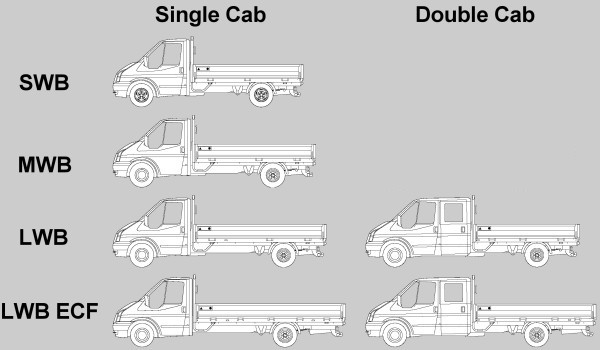 Tippers were less common than the similar-looking dropside trucks. As the tipping gear is not normally visible the best way of identifying such vehicles seems to be the squarer rear wheelarches fitted, as seen on 6480F on the left. Even more unusual was a battery-electric powered Transit dropside acquired by Go-Ahead London. Equally rare were box trucks, the central fleet featuring just one (6685F which replaced similarly unique 5519F). Bus company Arriva London used a curtain-sided Mk7 chassis cab in its engineering fleet, as seen on the right. Two further 'non-standard' Mk7 Transits in the central fleet were 6296F (left), a mid-height van fitted with a cherry picker lift, and 6516F (right), which had a custom-built body for its role as a rapid response vehicle. A new Transit range was launched in 2012-2013, with the plain Transit name now only used on the largest vehicles. Smaller (front-wheel drive) vehicles were now to the Transit Custom model (q.v.). Service vehicle users seemed slow to adopt the new Transit Mk8, with the first examples not being taken until early 2015. Early arrivals were LUL 7956F (left, a MWB mid-height crew van) and 7947F (right, a LWB high-roof van). The Mk8 Transit van was available in three lengths and two heights, although the designations of these were slightly odd. As the diagram below shows, there was no L1 variant (short-wheelbase) and no H1 variant (low-roof). Perhaps these were skipped so that common descriptions could be used across the Mk8 and Custom models. For example, the wheelbase of the longest Transit Custom is the same as that on the shortest Transit Mk8.  Compared to the equivalent Mk6 and Mk7, the LWB EL (extended length) Mk8 has black skirting panels behind the rear wheels, with no body colour section (as seen on 7948F on the left). In fact, due to the large black rubbing strip along the whole length of all Mk8 vans, there is little space left for the blue portion of LUL's standard livery. The new Transit is also available as a minibus, although none have yet been used as service vehicles. One oddity was a van with a hydraulic hoist (8470F, right). The Mk8 Transit is also available as a chassis-cab in a total of five different lengths. Double cabs are an option on all but the shortest model. Most service vehicle Transit chassis-cabs have been LWB ECF (extended chassis frame) models bodied as dropsides. One of the earliest examples was 7909F (left). Curiously, while the use of double cabs (crew-cabs) had been very common on LUL Mk6 and Mk7 Transits, most of the Mk8 dropsides have had single cabs. One of the exceptions was 8472F (right), also notable for being a LWB model (not ECF). As with earlier versions, box trucks based on the Transit are rarely used as service vehicles. The only example reported to date is LUL 8541F (left). The model gained a very subtle facelift in 2020, the main visual difference being the elimination of the body-coloured gap between the front grille and bumper, as seen on 8845F on the right. The Transit Connect was launched in 2003 as a replacement for the Ford Escort van. It was based on the chassis of the Ford Focus car (which had earlier replaced the Ford Escort car) and came in two basic sizes. The difference between the short-wheelbase low-roof van (such as 5946F on the left) and the long-wheelbase high-roof van (like 5779F on the right) was only 250mm in length and 170mm in height. Numerous options were available in terms of doors and glazing, these two showing the most common configuration of cargo door in the nearside only. The application of standard LUL livery varied considerably on Transit Connects. The design features a rubbing strip with three horizontal scallops beneath, and the blue skirt covered either one (left), two (right) or all (above) of these. Note that 5852F on the left has no side cargo doors.  The Transit Connect Mk1 was only available in two sizes - LWB high-roof (red) and SWB low-roof (blue). A minor facelift in 2006 saw the front bumper become smoother, and the grille flatter. The Ford badge was moved from the bonnet to the grille. This can be seen on low-roof 6318F on the left (which is unusual in not having a rubbing strip) and high-roof 6320F on the right. A further facelift in 2009 introduced a front grille that shared features with the Mk7 Transit. One of the first reported was high-roof 6838F (left) in the then-new London Underground livery. The white bumpers were a feature of higher-spec Transit Connects, with most service vehicles being to the basic spec with black bumpers, as seen on low-roof 6956F (right). The Transit Connect was also available as a crew van (with additional seats and side windows), though very few were taken as service vehicles. The first reported was Metronet 5687F (left), while LBSL Technical Services used a couple including 7031F (right). Also configured as a crew van was high-roof 7275F (left), one of the last Mk1 Transit Connects for the central fleet. EU61CRZ was a one-off, high-roof Connect which had been modified to run on electric power by Azure Dynamics. It was trialed by LBSL but no more followed. Note the odd window arrangement. A whole new Transit range was announced in 2013, included a totally revamped Transit Connect (referred to here as the Mk2). Metroline was an early convert, taking several short-wheelbase vans including AX14KZA (left). LUL 7930F on the right is an example of the long-wheelbase version. Unlike the Mk1, the new Connect was only available in one height.  The Transit Connect Mk2 was only available in two lengths - LWB (red) and SWB (blue). Both had the same body height. Both lengths of the new Connect were available in crew van configuration. Go-Ahead London EY67WUB (left) was SWB while LUL 8342F (right) was LWB. The original Transit Connect offered the option of having no side cargo doors (see 5852F above), but all Mk2s had at least a nearside door, with an offside door as an option. Crew vans were available with either glazed or unglazed doors on both sides. 8200F on the left is one of very few SWB Mk2s in the central fleet, and also shows the body-coloured bumpers of the Trend specification. Arriva GM66WWG (right) was LWB without an offside cargo door. A facelift of the model in 2018 saw the original slotted grille replaced by a larger, trapezoid one, linking to the design on the Transit Mk8 and facelifted Transit Custom (q.v.). The first (and so far, only) example for the central fleet was 8688F (left). The new grille can also be seen on Metroline AX19ZFF (right), and this view highlights the rather restricted access through the cargo doors, particularly on the SWB variants. As part of the new Transit range launched in 2012-2014, the Transit Custom model covered mid-sized, front-wheel-drive options. As an aside, the Custom name had previously been used as a specification level on Transits in the 1970s and 1980s. The new Transit Custom was available in two lengths and two heights, and as a van, a crew van or a minibus. LUL took many crew vans, including SWB 7933F (left) and MWB 8400F (right). 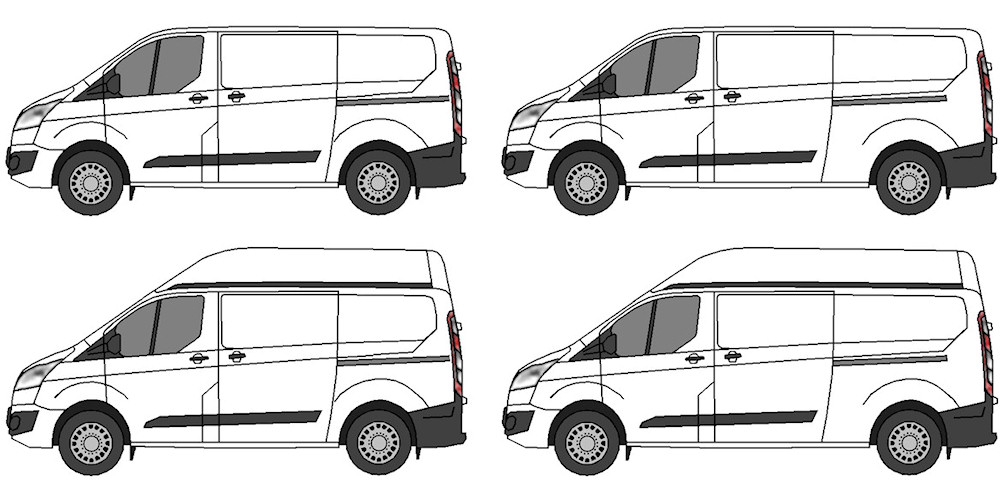 The Transit Custom was available in two lengths and two heights. Because of the tapering body pressings, the longer versions can best be recognised by the 'window' panels being shallower towards the rear. Other differences are the gap between the black rubbing strip and the rear wheels, and the gap between the side door runners and the rear lights. Very few high-roof Transit Customs have been added to the central fleet, but the type has seen use as an engineering support van with various bus companies. The length differences between SWB EF19HFV (left) and MWB LS15OXJ (right) are evident. Note that the longer versions are referred to as Medium Wheelbase, though there is no Long Wheelbase option. This is to relate the dimensions to those of the Transit Mk8 family. In terms of minibuses, the Transit Custom name is applied to vehicles with a basic specification, while more upmarket versions are branded as Tourneo Customs (q.v.). Most Transit Custom minibuses are low-roof, and include both SWB and MWB versions. Note the height of the side windows at the rear of SWB YL14JTO (left) compared to those on MWB YA13YJB (right). The Transit Custom design was updated in 2018, now featuring a large front grille. The shape of this grille was common across several Ford models. 8738F (left) was a SWB crew van with LUL, while 8721F (right) was a MWB van. Hybrid and fully-electric versions of the Transit Custom are available but their adoption has been slow, presumably because of range concerns. TfL took three electric Transit Custom vans on trial in 2018, including ET66AKF (left). While most 'green' vehicles tend to be given promotional lettering, 9136F (on the right) had none. This was one of the first hybrid Transit Customs reported, and the flap for the charging socket can just be seen to the right of the front grille. Completing the new Transit range in 2014 was a small van badged as the Transit Courier. As with the original Ford Courier, this was based on the chassis of the Ford Fiesta car. The new van was only available in one size but there were options of having no sliding cargo doors, one on the nearside only or one on each side. The Transit Courier was also available as a crew van, branded the Transit Courier Kombi. This featured sliding side doors (usually glazed) on both sides, as seen on LUL 8066F (left). The design was updated in 2019, with the shape of the front grille being subtly changed. This can be seen on Falcon Buses EA21KF (right). The Tourneo was a rebranding for the smaller Transit minibuses, these being aimed at more 'executive' roles. The first recorded vehicles were Mk5s like 4820F on the left. Differences from the standard minibus included colour-matched bumpers and a single-piece rear tailgate. Travel London T993SUF on the right is also a Tourneo but unusually features black bumpers. The Mk6 Tourneo lost the colour-matched bumpers (as shown by anonymous LUL example KD55MHA on the left) but retained the single piece tailgate (as seen on 5647F on the right). Tinted glazing appears to be a standard feature. Body-coloured bumpers (or more accurately grilles, as the side bumpers remain black) made a return with the Mk7 Tourneo, illustrated by 6280F on the left, while the top-hinged rear door is shown to advantage on similar 6249F on the right. As the name suggests, the Tourneo Connect was a minibus version of the Transit Connect van, although given the size it could almost be classed as an estate car. All were based on the longer and taller Connect bodyshell, with all-round glazing (tinted in the passenger area) and side-hinged rear doors. Most featured smarter wheeltrims than the van equivalents. The tinted glazing is apparent in the photograph of 6099F on the left, while 6848F on the right was the first example seen of the 2009 model. Following the launch of the four new Transit models in 2012-2014, the Tourneo continued as the Tourneo Custom and Tourneo Connect. 7887F (on the left) was a Tourneo Custom for LUL, showing the original front grille design and also body-coloured side rubbing-strip, mirror housings and front panelling. Metroline AV68AYZ (on the right) is to the revised design. These featured a chrome surround to the front grille, but the colouring of the rubbing-strip and mirror housings varied depending on specification. This article is also available as a downloadable PDF. To view the file, left-click the link below. To download the file, right-click the link and select 'Save link as...'. article003.pdf |